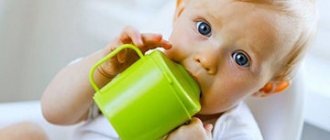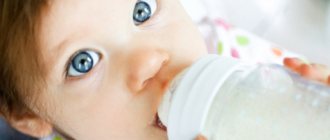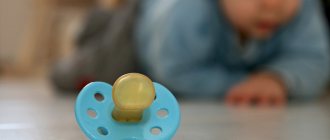IN THIS ARTICLE:
- What is a sippy cup and how to teach a child to drink from it?
- When can I start using a sippy cup?
- How to teach a child to drink from a sippy cup?
- What to do if a child refuses a sippy cup and wants to drink straight from a mug?
- How to use a sippy cup correctly?
- What and how much can you give your child in a sippy cup?
Sometimes the transition from a bottle to drinking from a cup is very difficult for a child. To help your baby, pay attention to the sippy cup. We will help you figure out why you need it, how to choose it and when is the best time to start using it.
What is a sippy cup and how to teach a child to drink from it?
A sippy cup is a training cup, usually plastic, with a screw-on or snap-on lid and a drinking spout. This design allows the baby to drink from it without spilling the liquid. There are models with different types of spouts, with or without handles.
A sippy cup is a great thing that will help your child learn to drink from a cup faster. It will also improve his hand-to-mouth coordination. If your baby already knows how to hold a cup, but has not yet learned to drink without spilling its contents, a sippy cup will give him more independence and minimize the need for cleaning.
What to do if your baby doesn't show interest
If the baby does not show initiative in getting to know the new mug, then the best way to arouse his interest is to demonstrate the pleasure of the mother and other family members when using it. Drink from the mug yourself, praise it, smack your lips with pleasure and sigh - do everything to make you want to try what’s so delicious. Perform a puppet show with treats for the toys and their “delight.” This will definitely work, and when the little one wants to repeat your actions, praise him by helping him take the first sip.
It is important to prevent the baby from choking when drinking, so there should be very little liquid in the cup. As you master a new skill, the amount of drinking increases. In very rare cases, you have to use a teaspoon as a transition tool from the bottle. As soon as the ability to drink from a spoon becomes a habitual process, offer a mug.
Sometimes a baby cannot understand that in order to drink he needs to close his mouth in a certain way and therefore wets himself. Press his lips lightly with your fingers so that he can properly grasp the edge of the cup and drink on his own without spilling.
How to teach a child to drink from a sippy cup?
Some children adapt to the sippy cup immediately, while others need time to get used to it. There are also kids who don’t use it at all. Here are some tips for introducing a sippy cup to your little one:
- It is better to start with models with a soft and flexible nose. It will feel more familiar to your child than the hard plastic one.
- Show how to lift the cup to your mouth and tilt it to drink. Let your baby understand that the nose is similar to a nipple. Stimulate the sucking reflex by touching the tip of the sippy cup spout to the baby's palate.
- Do not rush. Until your baby gets the hang of it, you can fill the sippy cup with water only to avoid unnecessary mess. And don’t worry if your baby can’t immediately grasp the cup correctly. Just wait a few weeks and try again.
- Buy several models. Today there are many types of sippy cups with a variety of spouts. Try different ones until you find the perfect one for your baby.
Other ways to accustom your child to a mug
If your child flatly refuses a mug, you can use other ways
- Give his dolls and stuffed animals a drink.
- Show him that drinking from a mug is very convenient and pleasant.
- Start feeding him with a spoon, and when he gets used to taking a few sips, move on to a cup.
Possible difficulties
If your baby is not feeling well or has started teething, you should postpone training until better times. Don't forget that the baby has an ejection reflex, so he will try to push any unfamiliar object out of his mouth. Try to find a cup that your baby likes. When teaching him to drink from a mug, place his favorite toys around him, this will make him calmer. The baby will teach his dolls to drink from dishes. This will help him fall in love with the new way of drinking.
Each baby is individual, so it is impossible to set any specific training time frame. It may be that your child is not ready to learn yet, there is nothing to worry about. The training may take a week, or it may take three months. Patience will be your main assistant during this period. Remember to praise your child and never scold him. Remember that this learning time should leave only bright memories in the child’s mind.
Comments ()
What to do if a child refuses a sippy cup and wants to drink straight from a mug?
A baby may refuse a sippy cup for a variety of reasons. This is not a necessary condition for its development. Some children immediately start using a regular mug after stopping breastfeeding or bottle feeding. But if you want to teach your baby to use a sippy cup, you will need some tips that have helped other parents successfully cope with this task:
- Dip the spout into breast milk or formula before giving it to your baby. You can also try giving your baby a pacifier without a bottle, wait until he makes a few sucking movements, and replace it with a sippy cup.
- Try making a feeding change. If you are using a bottle, fill it with half your usual amount of formula or breast milk. When the bottle is empty, switch to a cup for the rest of the feeding, continuing to support it with your hand.
- Adjust the sippy cup valve. In some models, it prevents spills so effectively that it is very difficult to drink from them. If your child is sucking on the spout but not drinking anything, try removing the valve that controls the flow of liquid (if it has one and is removable).
- Do the opposite: first teach your child to drink from a sippy cup without a lid. Pour one or two teaspoons of liquid into a cup and help your baby bring it to her mouth. When the child gets used to it and understands that it is not empty, close the lid (without the valve, if there is one). Then, insert the valve and let your child try it for themselves.
- Offer me a straw. There are models already with a built-in straw. Some children find it easier to use than a spout. If your baby understands how to suck from a straw, he or she can then become better at drinking from a spout.
- Show me how to drink correctly. Take the sippy cup in your hands and take an imaginary or real sip in front of your baby. Sometimes, a little smacking will make your baby want to suck, which the sippy cup will satisfy. Make sure you give your child clean dishes. Sharing a child's sippy cup can increase the amount of tooth-damaging bacteria in his saliva.
- Try other drinks. Some children happily drink water or juice from a sippy cup, but reject breast milk or formula in it. But do not give juice to a baby under one year old and limit its consumption to 0.5 cups per day from 1 to 3 years.
How to choose a sippy cup?
The sippy cup is easy to use - the lid and spout prevent the child from choking or spilling the contents on himself. Using a sippy cup does not disrupt the baby's teeth bite. There are many types of sippy cups: with or without a threaded lid, with or without handles, sippy cups, with spouts or a straw.
When choosing, you should pay special attention to how easily the liquid flows out - the baby should not throw back his head too much to take a sip. During the training period, several types of sippy cups may be needed, depending on the situation and their purpose.
Types of sippy cups
Children's sippy cups differ in their type, as well as in the recommended age category:
- The sippy cup for children up to 6 months consists of a silicone tip and nipple. The nozzles are replaceable - they can be alternated if necessary.
- A sippy cup is a sippy cup with a valve. When drinking, the valve opens slightly and returns to its original position when turned over.
- Thermos sippy cup. Thanks to its double walls, this sippy cup is able to maintain the temperature of the drink for the whole day. It is necessary for long winter walks in nature.
- Container with a straw – has a removable top lid into which a special drinking straw is inserted.
- A bottle with a silicone or plastic tip. Removable lids with a silicone tip are in demand - if they get dirty, they are easy to wash, and the silicone tip is more pleasant to the touch.
- A tumbler is a sippy cup made of durable material. The special shape of the bottom of the sippy cup prevents it from tipping over and spilling the drink. Suitable for active children who like to throw objects onto the floor.
There are many types of sippy cups.
Children's sippy cups also differ in their recommended age group - this information should be indicated on the packaging. Each age group has a specific hole width, which allows you to regulate the amount of drink you swallow in one sip. Sippy cups should be considered as auxiliary utensils when transitioning to drinking from a cup.
The baby gradually weanses the habit of using a bottle with a pacifier and learns to bring the sippy cup to his mouth on his own. This capacity allows you to achieve the desired skill without additional parental care. At the same time, drinking does not cause discomfort to the baby - he remains clean and dry.
Measures for using the sippy cup
Before any use, the sippy cup should be washed thoroughly. It is also necessary to clean all removable parts every time. Make sure there are no chips or damage. If a crack is found, the sippy cup should be replaced with a new one. Do not let your child drink from a sippy cup while lying down. Do not store leftover food or drink in a sippy cup, or mix leftovers with fresh portions. The contents in the sippy cup should be age-appropriate.
How to use a sippy cup correctly?
Using a sippy cup may seem easy, but there are pitfalls that are important to be aware of:
- Never allow your child to drink juice or milk while lying in bed, or to walk around with a sippy cup in hand for several hours at a time. When he is thirsty, it is better to give him water before his main meal instead of juice or milk. Otherwise, sugar may accumulate in the baby’s mouth, which will create a favorable environment for the development of caries.
- Wash the cup (especially the lid and plastic stopper) thoroughly between uses. Liquid can easily get into the nooks and crannies of the cup and valve, causing bacteria and mold to grow. If you can't wash the sippy cup right now, at least give it a good rinse. If this is not possible, drain the unnecessary liquid and disassemble the sippy cup. Periodically check caps and valves for damage or mold.
- Don't expect a sippy cup to be the magic solution to ending breastfeeding. For some children, it simply replaces the bottle, and in the future you will also have to wean your baby off it. However, many parents find a sippy cup more acceptable for their child. When used correctly, it is not that harmful to teeth.
- Do not use the sippy cup for too long. Once your child gets the hang of it, switch to a regular cup. By age 2, most babies can drink from an open cup with two handles.
When to teach your baby to drink from a cup
In fact, if a child understands what a utensil such as a mug or cup is intended for and can hold it in his hands, it’s time to teach him the simple science of drinking like adults. Another sign that the child is ready for such training is the mobility of his fingers and the ability to sit down.
It doesn’t matter that more than one mug will be broken during the training, parents should be prepared for this, because the hands of a small child are not as obedient as those of mom or dad. He is just learning to do everything on his own, but over time his fingers will get stronger, and the baby will be quite confident in holding dishes.
Apparently, pediatricians are of the same opinion that it makes sense to accustom a baby to such utensils at 7 or 8 months. In addition, a baby at this age, as a rule, is on complementary foods and has already tried various pleasant liquids - herbal tea, juices and compotes.
If the baby learned to sit early, and parents can’t wait to introduce him to a cup, then we can advise them to start with sippy cups. This is a special dish that looks a little like a bottle and has a spout with a hole. It is much easier to learn with it, and later it will be time for a cup.
Doctors believe that you should not use a bottle at all if the child was completely breastfed. It also makes no sense to wait until the baby is a year old, one and a half years old or more. It will be very difficult to wean you off the bottle.
What and how much can you give your child in a sippy cup?
If your baby is under 6 months old, simply offer a serving of breast milk or formula in a sippy cup every day.
As a rule, breastfed or bottle-fed babies do not need water or juice for the first six months of life. Remember that babies under one year old should not be given cow's milk.
If your 6-month-old is thirsty between feedings, fill his sippy cup with water. Children aged six months and older can have up to 120 ml of 100% fruit juice per day as an addition to formula or breast milk. But don't offer it before bed to prevent tooth decay.
As soon as a child begins to drink whole milk (after reaching 1 year), experts recommend giving no more than 960 ml of milk and half a glass of juice per day. Otherwise, this will lead to caries, and the baby will most likely be full before the main meal.
When is the best time to start studying?
You should start feeding your child from a mug no earlier than he has mastered two main skills, without which learning will be impossible: he must sit confidently and be able to drink from a spoon. Due to the fact that anatomically drinking from a bottle occurs differently, you cannot feed a baby from a mug while lying down or half-sitting, because he may choke. The ability to keep your back vertical will protect you from this danger. The ability to sip liquid from a spoon is a prerequisite for developing the skill of drinking from a cup because it involves the same physiological processes.
The optimal age when you can start teaching your child to drink from a mug is 7-8 months. By this age, the baby is able to hold objects in front of him for a long time. This means that the small cup will not slip out of his hands. And getting to know different types of complementary foods taught him to take food from a spoon.
Don’t forget that while playing, children learn faster, so having chosen together a beautiful, bright, comfortable and most importantly unbreakable sippy cup, the mother already at this stage involves her child in a new interesting activity, starting learning.
The sippy cup is a good helper
The replaceable sippy cup attachments first resemble a pacifier; the baby draws in the liquid, making sucking movements. Then, when a sippy spout is put on the glass, the drinking process becomes similar to sipping from a cup. At the final stage, the nozzles are removed - what remains is an ordinary mug. This results in a consistent transition from simple actions to more complex ones.
A sippy cup is an indispensable helper when the bottle has already been abandoned, and the skill of drinking from a mug has not yet been developed. It is easier to drink from it without the risk of spilling liquid. However, you should not get carried away with it for long. It is advisable to switch to the cup as soon as the little one begins to confidently use the spout attachment.
When to give
Buckwheat porridge for babies - how to cook buckwheat at home
Newborn babies who are breastfed do not need additional water until they are 6 months old. At six months, most children begin to eat solid food, and then they start learning to drink. For bottle-fed babies, the rules are different - after the first month they begin to learn to drink from a special drinking bowl, bottle or even mug. Children especially love the sippy cup, from which they can quickly and independently learn the necessary techniques.
Important! Most pediatricians believe that both artificially born and breastfed children need fluids a month after birth. The recommendations are supported by the opinion of WHO. Supplementation of children is necessary in hot weather, with colic, constipation and congenital jaundice.
About the sippy cup
The controversial question - is it possible to use a special sippy cup or is it better to immediately teach them to drink in mugs - worries many parents. Pediatricians note that each mother must decide it individually. Some children grab a cup with interest and start drinking without any problems; they clearly don’t need the transitional option. Other kids quickly get used to sippy cups, which allow them to drink even while lying down, which is very convenient. Also, this method is most often used to accustom babies who are not familiar with nipples and who are breastfeeding. Some mothers combine - only a mug during the day, and a sippy cup at night.
Therefore, when deciding whether to buy a sippy cup or immediately start “working” with a cup, every mother should focus on her baby.
How to start training?
Having chosen a suitable mug for your baby, you need to show him how to drink. To do this you need to do the following:
- pour some water (you can give the child his favorite juice or compote);
- bring it to the baby's mouth and give him a drink.
The essence of this “training” is simple - the child must understand why he needs a new object, a mug. If he wets himself, the mother should not swear or be nervous, otherwise the baby will develop a negative attitude towards the dishes, and the further learning process will be difficult. Also, under no circumstances should you pour liquid into your child’s mouth. If he refuses to drink, it is necessary to reschedule the lesson to the next day, when the baby is in a good mood.
The next step is to hide the bottle. She must disappear forever from the child’s visibility. When he wants to drink, his mother should show him a cup of water and help him take sips. There are situations when children categorically do not accept an innovation, then experts advise to cheat a little: pour something tasty and loved by the baby into a cup, and his least favorite drink into the bottle. Then let me try both. Most children will lose interest in the bottle and reach for the mug. At first, the mother can hold the dishes, then she can only support them, giving the baby the opportunity to grasp the mug with her palms. This is how the child learns to drink completely independently.
Once you give up the bottle, you can’t go back to it. If a child behaves badly, you can offer him a drink from a spoon, but do not give in.
How much fluid does a newborn need?
Teething schedule for children under one year old
The norms and amount of water depend on the age, weight and nutrition of the baby. So, you can avoid using it while on guard for up to 6 months. Infants need to additionally give it in the amount of 20 ml 4-5 times a day, and also clearly monitor the amount of liquid introduced into the mixture.
Table of the amount of formula and water during feedings
Advice. After introducing complementary foods, the amount of liquid is calculated using the formula: 50 ml * child’s weight.











